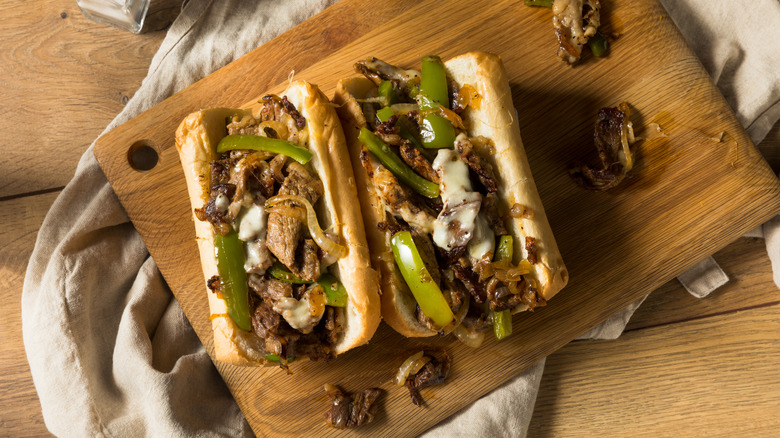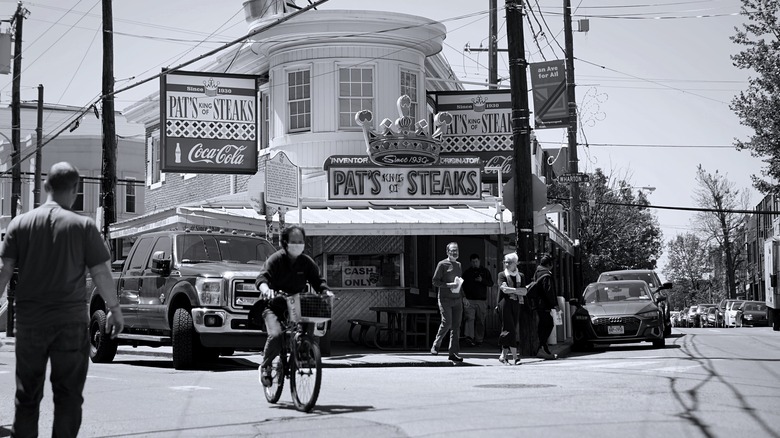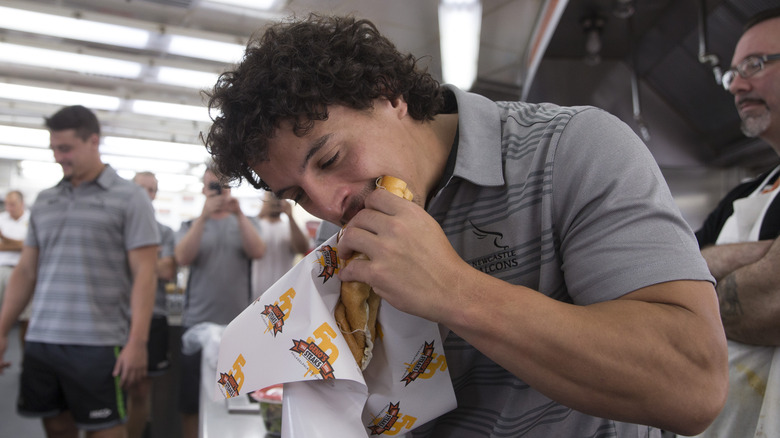The Best Way To Eat A Philly Cheesesteak, According To An Expert
Imagine sinking your teeth into a juicy sub sandwich, hot grease spilling down your chin with every bite. That's a culinary gift from the gods. As most food lovers know, sometimes you don't go grabbing a bite to eat for fuel, but to relish in that special experience surrounding the meal. Every new dish comes with a new perspective, vocabulary, sense of pride, and peek into the culture from whence it came, and sometimes you just gotta have a taste.
A classic Philly cheesesteak can offer all of that and more. Picture those thin slices of well-done steak, a smattering of melted cheese, and whatever other fixings are grilled up by the guy in charge, all happily tucked into a soft, sliced roll. Its simplicity is its power and is what makes it one of the best greasy foods in America. The question isn't should you get a Philly cheesesteak for lunch, but should you get it "wit" or "witout"? (In other words, per the Philadelphia Inquirer, do you want onions?)
Although the sandwich feels as old as time because of its consistent popularity, the sandwich's origins are from less than 100 years ago. And while the cheesesteak has evolved since, one thing about the sandwich hasn't: How you should eat it. If no one has ever told you the proper way to consume these hearty steak sandwiches, let us be the first to tell you. And for your own safety, don't forget it!
The origins of the iconic Philly cheesesteak
Despite the simplicity of a Philly cheesesteak's contents, the beloved sandwich has a rich history, per Billy Penn. The classic sandwich has its origins in the 1930s when two brothers grew tired of eating hot dogs. Pat and Harry Olivieri ran a hot dog cart in South Philadelphia, situated snugly in a bustling Italian neighborhood, per Philadelphia Magazine. Many people stopped by the stand for a quick lunch on the go, but as time passed, the two grew tired of eating the same food for lunch day after day. Finally, they decided to do something about it. The brothers decided to experiment with a few scraps of beef from the butcher, some grilled onion, and a hotdog roll. A cab driver saw the sandwich being made and asked for one of his own, which the brothers split with him. The creation was an instant hit, and almost 100 years later, the building across the street from where the cart once stood now houses the famous Pat's King of Steaks.
It's important to note that the original recipe did not include cheese. Cheese came in the 1950s — the first being a provolone variety — and the history of that addition is unclear (but most credit a Pat's employee for the new ingredient). Now you know how this sandwich came to be. But if you're planning on indulging in one anytime soon, make sure you're eating how it was intended.
How to eat a Philly cheesesteak the right way
To truly complete the experience of enjoying a Philly cheesesteak, you've got to eat it the right way. As the author of "The Great Philly Cheesesteak Book," Carolyn Wyman told First We Feast, the best way to eat a Philly cheesesteak is not sitting at a table with a napkin in hand. The absolute ideal method is to cut your sandwich in half, bring it outside, and eat it out in the open air. You'll be glad you brought this messy indulgence into nature so that its signature grease can drip freely as it's meant to. Fewer napkins equal less waste, too, right? And there will be little worry about needing to use a stain remover later too. Just make sure to tie back your hair and secure all those loose accessories!
Although some may see this as a niche, maybe even animalistic way to indulge, the technique has been restated by others, including Pennsylvania-based former Congressman Bob Brady (per Philadelphia Magazine). (Brady also called former president Bill Clinton out on his bad behavior when he sat down to a cheesesteak at a table while visiting Pat's restaurant in Philadelphia.) So whenever you sink your teeth into this sandwich, think about the City of Brotherly Love and the unique way you should eat its most popular culinary creation. When you see the puddle of grease at your feet, you'll understand why.


